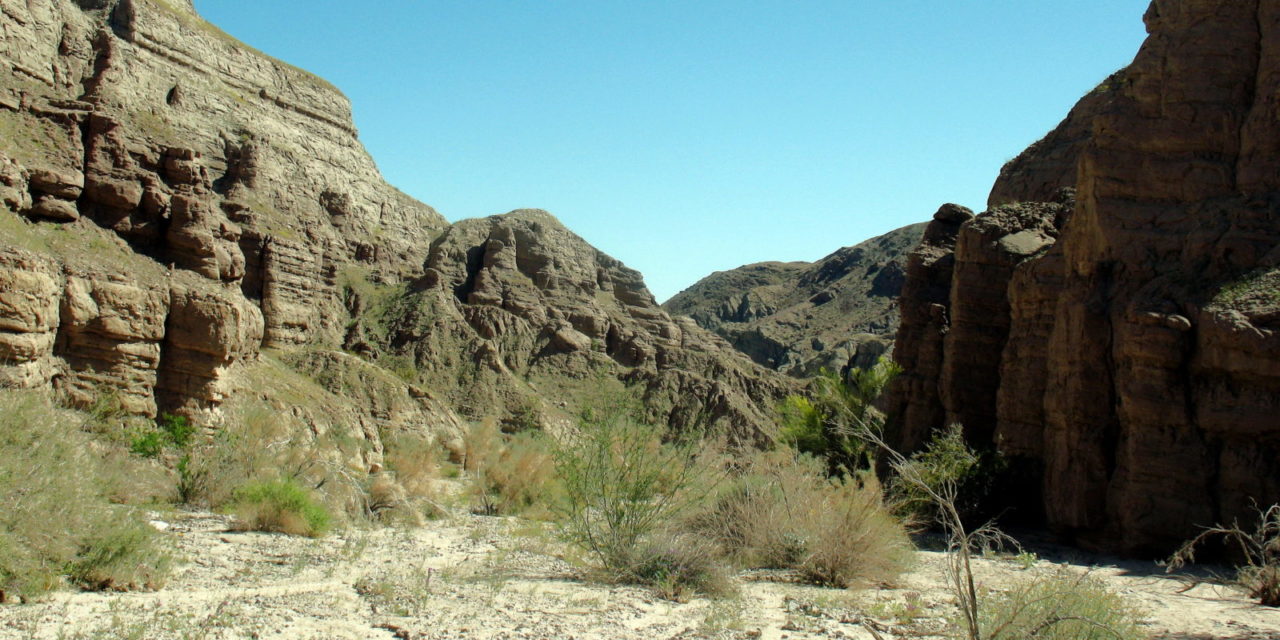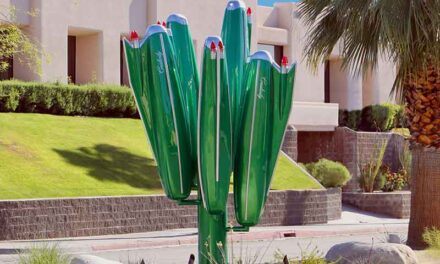Little Painted Canyon sits in the heart of the Mecca Hills.
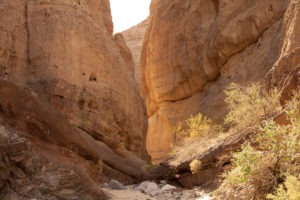
The wash quickly narrows into a slot canyon.
Hikers can see fascinating rock formations as heading up a slot canyon in the Mecca Hills Wilderness Area.
The 2.5-mile round trip Little Painted Canyon Trail is a nice alternative to the popular Ladders Canyon trail – they share the same parking lot, and though you may find almost every spot filled, most hikers are in Ladders Canyon, ensuring you enjoy a peaceful walk up the Little Painted.
To reach the trailhead, take Calif. Hwy. 111 to Mecca. Turn left/northeast onto Fourth Street then at the roundabout go right/southeast onto Hammond Road. After a couple of blocks, go left/east onto 66th Avenue. As the street curves northeast, it naturally becomes Box Canyon Road. After crossing the canal, in a little more than a half-mile turn left/northwest onto the gravel Painted Canyon Road. That road can be sandy and sometimes is washed out; a four-wheel drive is recommended. Ultimately, the road winds into a canyons, ending at a sand parking lot. The trail heads northwest from the lot into an initially wide, open canyon.
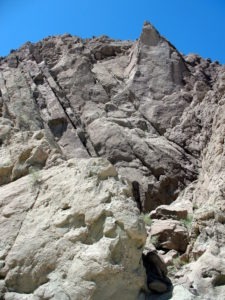
Uplift has moved some of the canyon’s rocks almost 90 degrees from the near horizontal direction that they formed.
As water washes down the canyon after a rainfall, the trail surface mainly is sand, which can be deep at times. The elevation change is gradual, though, as you gain a total of 300 feet by the time you reach the trail’s end.
Little Painted Canyon sits in the heart of the Mecca Hills. It sports rocks in a variety of hues, including pink, rose, red, purple, green, beige, gray and brown. Quartz also can be seen.
The canyon formed because the Mecca Hills are being uplifted as the North American and Pacific tectonic plates slide against one another along the nearby San Andreas Fault. When rain falls across the nearly barren hills, the rushing water cuts through the rock, forming the canyons. Some of the exposed rock at the canyons’ lowest points are more than 600 million years ago.
The wide wash at the start of the hike quickly narrows to a slot canyon. Because of this, at times, the hike feels otherworldly.
There are a lot of side canyons to explore if you’re looking for a longer hike, but don’t go up them without a topo map and compass. Even experienced hikers easily can get turned around in the maze of canyons.
Especially after a rainfall, there’s plenty of green in spots. Ironwood, palo verde and smoke trees prosper in the sandy wash. Ocotillo grows on the canyon rim. Keep an eye out of the Mecca aster, a rare lilac-colored flower than looks like a daisy. It only grows in Riverside and Imperial counties with most of the known populations in the Mecca and Indio hills.
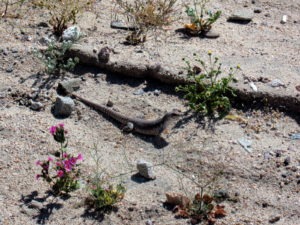
Among the canyon’s denizens is the desert iguana.
Running amid the greenery is the desert iguana, which is common across the Sonoran and Mojave deserts. The pale gray to tan lizard can grow up to two feet long. Look for them around creosote; if spotted, it’ll likely scamper toward the bush into a burrow it has dug under the plant.
If you’re lucky, you may see Bighorn sheep on the canyon rim. Bighorn living in the nearby Orocopia Mountains sometimes come into the Mecca Hills searching for water.
Much more likely to be spotted are prairie falcons. With a wingspan of up to a meter, they at most grow 19 inches long and weigh no more than 2.4 pounds. They nest on canyon walls and make a call that sounds like kree kree kree or kik kik kik.
About 1.25 miles in, the trail reaches a steep waterfall that’s almost always dry. This marks a good spot to turn back.
Alternately, you can climb out of the canyon and take a gander from on high. As facing the waterfall, scramble up the slope on the left to a narrow ridge that in short order heads to the canyon top. Looking south offers an impressive view of the Mecca Hills’ labyrinth of canyons and ridges.
When hiking this trail, always start early to avoid the sun and heat. The trail periodically closes for flooding; never hike the trail if rain has fallen during the past 24 hours or is forecast for that day.
Dogs are allowed on the trail.
Image Sources
- Little Painted Canyon: Rob Bignell

